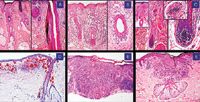- Acne
- Actinic Keratosis
- Aesthetics
- Alopecia
- Atopic Dermatitis
- Buy-and-Bill
- COVID-19
- Case-Based Roundtable
- Chronic Hand Eczema
- Chronic Spontaneous Urticaria
- Drug Watch
- Eczema
- General Dermatology
- Hidradenitis Suppurativa
- Melasma
- NP and PA
- Pediatric Dermatology
- Pigmentary Disorders
- Practice Management
- Precision Medicine and Biologics
- Prurigo Nodularis
- Psoriasis
- Psoriatic Arthritis
- Rare Disease
- Rosacea
- Skin Cancer
- Vitiligo
- Wound Care
Article
Exercising caution: Follicular melanoma remains unknown, poorly characterized
Author(s):
Folliculotropic melanoma demands timely action, as little is known about the disease's potential aggressiveness.

Key Points
Cleveland - Little is known about folliculotropic melanoma, due to the scarcity of reported cases.
However, because it is still unclear how aggressive this melanoma type can be, caution is warranted when a histologic picture indicates folliculotropic melanoma.

The more extensive involvement of melanoma and melanocytes into hair follicles and the heterogeneity by which melanoma can invade follicles is an area that needs more discussion, says Najwa Somani, M.D., of the department of dermatology and dermatopathology at the Cleveland Clinic, Cleveland.
"Prior studies have shown that in up to 96 percent of cases of melanoma in situ occurring on sun-damaged skin, you can see extension far down into the follicle," she says.
"The pattern seen here is usually a sheathing of single cells along the outer root sheath of the follicle. Just how much this migration into hair follicles translates into the level of aggressiveness of this tumor type remains unknown," Dr. Somani tells Dermatology Times.
Case study
In a recent case study, Dr. Somani saw a folliculotropic metastatic melanoma in a 70-year-old male patient who developed three separate melanomas over a two-year period.
The initial melanoma presented as a darkly pigmented papule on the left abdomen, which soon metastasized to the left cheek and supraclavicular areas.
The primary melanoma showed a histology of a superficial spreading melanoma (Breslow >0.4mm, Clark V), as well as a prominent folliculocentric destructive pattern of growth.
The subsequent two metastases showed a very similar folliculocentric destructive growth pattern with very little intra-epidermal involvement, and all three tumors demonstrated a high mitotic index upon Ki-67 immunohistochemical stain.
All three tumors were treated with a wide local excision without sentinel lymph node biopsy.
Reporting differences
Folliculotropic melanoma is a little-known entity, and, therefore, there is a great deal of variability in the way dermatopathologists report the follicular invasion.
According to Dr. Somani, a consensus on how to report these lesions, as well as a standard of care, must be agreed upon in respect to how these follicular melanomas should be dealt with.
"The differences in the reporting of the histology can lead to interpretation variability and measurement variability and, ultimately, that can affect the way that a clinician might ultimately treat the patient," Dr. Somani says.
Database review
In a recent database review of melanomas reported between 1987 and 2007 at the Cleveland Clinic, Dr. Somani identified only 26 cases that were actually reported as follicular melanoma.

Of the 26 reported folliculotropic melanomas, 14 were melanoma in situ and 12 were invasive melanoma. Though the sample size was limited, Dr. Somani explains there was no evidence that folliculotropism actually changed the prognosis or increased the risk of metastasis.
The mean follow-up for the cases of invasive melanoma was three years and seven months, and none of the lesions metastasized or recurred.
Newsletter
Like what you’re reading? Subscribe to Dermatology Times for weekly updates on therapies, innovations, and real-world practice tips.











